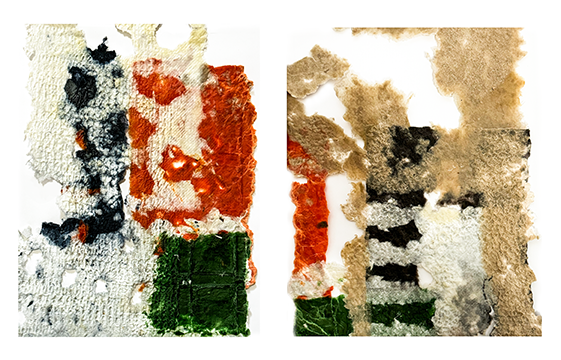Tick. 2023. Mixed media. 31 x 41 in.
Peach Grove. 2023. Peach-scented toilet paper, toothpicks. 50 x 50 ft. This project was made possible with funding support from the University of California Davis Performance Studies.
Cornerstone. 2024. Peach-scented toilet paper, beeswax. 16 x 16 in.
Parcel. 2024. Clay, red iron oxide, rutile, hydrostone. 12x8x8 in.
Supporting Silence. 2024. Paper, beeswax. 8 x 10 in. Collaboration with Aramo Olaya.
Grove is a speculative, material, and performative question of care, labor, and productivity, questioning the grid as an agricultural and social structure that mechanizes bodies and exhausts ecologies. Echoing industrial farming, squares of peachy (peach dyed and scented) toilet paper are planted in a grid. Through the laborious act of planting, my body is pushed to exhaustion and confronted with its own limits, as artificial perfumes leach into my skin. I have an allergic reaction. I am covered in hives, planting. A grove is inherently a gathering—a breathing ecosystem of trees that exists as space and rhythm. The growth patterns of the grove create connections between shadow and light. Beneath the soil, tree roots intertwine in networks, while above, foliage and fruit interlace into a shared canopy. A grove is a sanctuary, a stage, a threshold, and a story—a relational holding of the earth’s liveliness and the infinite rhythms it sustains. Grove seeks to rekindle these connections.
irvin, em. “Peach Grove.” Global Performance Studies 6, nos. 1–2 (2023).
Trip to the Future: A Zine on Fiction, Disability, and Speculation. Buzz Zine, Volume III. Behives.
Participants are guided through making a clay vessel through an audiovisual feed, a score, that demonstrates various ways to form clay into a vessel. Participants are then encouraged to use the clay vessel created to collect water and then offer me the water to drink as I sit waiting to receive. The score repeats in a loop for the duration of the performance.
Clay prepares to receive the form of a vessel. Bodies lie together. Approach. Offer one to your hands. Clay is ready, yet preparation to receive involves muscular coordination of the hands: squeezing, opening, contracting, and expanding as clay molds into a rounded shape, filling the hollow of the palms. This space is a site of rhythm, the hands opening and suspending clay, creating a momentum of rolling, rounding, and rotating—a loop, a rhythmic choreography. Pressure between hands is just enough to shape, compress, and keep the clay in motion without flattening or distorting it beyond the image of a sphere. Cradle clay within a network of interlaced fingers, weaving one hand’s fingers as intentional weft into the other’s. Bring the crowns of thumbs together. This flexible net supports the clay’s outer form as thumbs press deeply into the center. Thumbs slide out revealing a half clover. Turn the clay a half turn. Repeat to shape a full clover. Hear a faint crack as an air pocket bursts under the press—turbulent pressing. The elbow, the knee, the heel are other parts of the body capable of forming vessel space. These are different methods with the same body. Try with different bodies. Impress clay onto body contours, a colliding, crashing, surrendering. Attentive acting. Inviting the warmth and tremor of the body to shape the clay, the clay’s shape in its reciprocal image. Vessels need walls to sustain their holding potential. Hands pinch these walls, speaking to one another in a coordinated rhythm around and through form. Touch enables the simultaneity of speaking and listening, as hands feel wall thickness and consistency. Pinching is a dialogue between the consistency of actions and the thickness of form. Place clay vessel in the hollow of one hand, a cushioned space mirroring vessel shape, while the thumb of the opposite hand rests on the wrist, keeping both hands balanced and coordinated, forming a whole entity beyond the body's lateral divide. The soft roundedness of the stability of the pointer finger’s knife edge compresses the rim of the vessel. Pressure mirrors the beginning—an affective force preserving the shape formed. The fingertip or thumb pad smoothes the vessel’s sides, pressing the rim to echo the lips as they meet the mouth’s inner edge. The vessel is prepared. Carry the vessel to the water held with readiness—culmination of a political act. Dip vessel into water in an angular descent. Fill. Bring nurturing element to mouth—my mouth—sharing a boundless touch. Return clay to the bucket to prepare again.
Feed. Participatory performance. Practice as Research Performance Salon (P.a.R.P.S.), Mondavi Center for the Performing Arts, Davis, California, 2023. Sounds created with the assistance of Ryan Danley.





